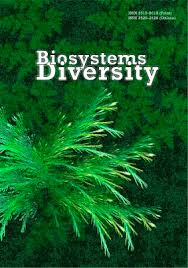Role of the bryophytes in substrate revitalization on a post-technogenic salinized territory
Role of the bryophytes in substrate revitalization on a post-technogenic salinized territory
Author(s): N.Y. Kyyak, O.V. Lobachevska, I.V. Rabyk, V. H. KyyakSubject(s): Agriculture, Energy and Environmental Studies
Published by: Дніпропетровський національний університет імені Олеся Гончара
Keywords: tailings storage; mosses; organic carbon; actual acidity; redox potential; microorganisms;
Summary/Abstract: This work aims to investigate the role of the bryophyte cover in substrate revitalization on a post-technogenic salinized territory. The influence of the moss cover on the organic carbon content, actual acidity, redox potential, and the content of the main ecological and trophic groups of microorganisms in the substrate of the tailings storage of the Stebnyk Mining and Chemical Enterprise "Polymineral" was investigated. Bryophytes significantly affect the tailings storage saline substrates. They colonize areas with a very strong and strong degree of salinity, which are unsuitable for other plants. It was indicated that pioneer moss species promote the accumulation of organic matter in saline substrates of the tailings storage. Under moss turfs, the amount of organic carbon increased 2.2–5.0 times, compared with its content in the uncovered substrate. The high variability of the organic matter content is determined by the species characteristics of mosses, primarily their life form. The dense-turf species Didymodon rigidulus and Pthychostomum pseudotriquetrum var. bimum accumulated the most organic matter. The thickness of the litter under the moss turf of these species was much greater than in Barbula unguiculata and Funaria hygrometrica, which form loose turf. We assessed the specificity of the accumulation of organic carbon in the turfs of the studied mosses. It founded that most organic matter accumulated in the dead parts of the moss turf. In the green parts of the shoots of these moss species the amount of organic carbon was 3–4 times less, which indicates a relationship between litter capacity and content of carbon in the substrate under moss turfs. We investigated the influence of mosses on the actual acidity of the tailings storage substrate. Moss turfs promote the increase of acidity of the aqueous solution of the tailings substrate by 0.2–0.5 units. The tailings storage substrates are characterized by a reduction regime. The redox potential of the substrate under moss cover significantly depended on the species characteristics of mosses. Under the moss cover, the redox potential increased by 1.2–1.4 times, compared with the index for the substrate without moss cover. We studied the influence of moss cover on microbial biomass and the quantity of some ecological-trophic groups of microorganisms in the substrates of the tailings storage. The amount of microbial biomass under moss turfs increased depending on the degree of the substrate salinization and the species characteristics of the mosses. In areas with a very high degree of salinization under the moss turfs of Didymodon rigidulus and Funaria hygrometrica, the microbial biomass index increased almost two times, compared with the uncovered substrate. We found a significant increase in the quantity of the main ecological and trophic groups of microorganisms (saprophytes, cellulose-destroying bacteria, oligonitrophils and nitrogen fixers) in the substrate under the moss cover. Thus, pioneer moss species have a complex effect on the saline substrate of tailings storage. They accumulate organic matter, increase the acidity of the upper layer, improve the redox regime of the substrate and promote the development of soil microbiota.
Journal: Biosystems Diversity
- Issue Year: 28/2020
- Issue No: 4
- Page Range: 419-425
- Page Count: 7
- Language: English

